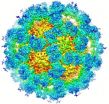(Press-News.org) ST. LOUIS, MO, March 21, 2012—Twenty million Americans get sick from norovirus each year according to data released last week by the Centers for Disease Control (CDC). Often called vomiting illness, it can spread rapidly on cruise ships, and in dormitories and hospitals. Recent data from the CDC shows deaths from gastrointestinal infections have more than doubled and have become a particular threat to the elderly. The virus is shed in the stool of the infected individual, has a short incubation period and can spread quickly if proper hand washing and other measures are neglected.
While researchers say that vaccines for intestinal infections are among the most difficult to develop, a recent discovery may provide the critical information needed for success. "Sometimes atomic structure gives us clues on how viruses work and how to make better vaccines," said Dr. Thomas Smith, principal investigator, at The Donald Danforth Plant Science Center whose recent article, Structural Basis for Broad Detection of Genogroup II Noroviruses by a Monoclonal Antibody That Binds to a Site Occluded in the Viral Particle, in the Journal of Virology was selected by the editors as an, "Article of Significant Interest, sighting the extreme norovirus flexibility suggested by these results may allow for broad antibody recognition, a finding of potential vaccine significance."
Smith was part of a team of scientists lead by Dr. Peter D. Kwong, National Institute of Allergy and Infectious Diseases, National Institutes of Health (NIH). Their research demonstrated that the virus has a structure unlike that of other viruses in that is has protein "lollipop" like structures that likely gives it more flexibility in attaching to cells. There are four genera of this virus family, the Caliciviruses, with the Sapoviruses and Noroviruses being the major cause of severe gastroenteritis in humans.
Dr. Smith and his colleagues discovered that because of the "lollipop" structure, antibodies against the norovirus may be able to bind to the more conserved underside of this floppy structure. This suggests that the extreme flexibility of the norovirus particle may allow for antibody recognition of protected surfaces that might otherwise be buried on intact particles.
This information will give researchers more insight on how to manipulate complex viruses as well as to design and develop better drugs to treat the maladies they cause. Rotovirus, a member of a different viral family but also causes severe gastro intestinal distress primarily in children, is being well controlled by the recent development of a vaccine.
INFORMATION:
About The Donald Danforth Plant Science Center
Founded in 1998, the Donald Danforth Plant Science Center is a not-for-profit research institute with a mission to improve the human condition through plant science. Research at the Danforth Center will feed the hungry and improve human health, preserve and renew the environment, and enhance the St. Louis region and Missouri as a world center for plant science. The Center's work is funded through competitive grants and contract revenue from many sources, including the National Institutes of Health, U.S. Department of Energy, National Science Foundation, U.S. Department of Agriculture, U.S. Agency for International Development, the Bill & Melinda Gates and Howard G. Buffett Foundations.
The Donald Danforth Plant Science Center invites you to visit its website, www.danforthcenter.org, featuring interactive information on the Center scientists, news, education outreach and "Roots & Shoots" blog to help keep visitors up to date on the Center's areas of research and programs.
Discovery offers insight into treating viral stomach flu
Lethal Norovirus has become the second leading cause of death from gastroenteritis
2012-03-22
ELSE PRESS RELEASES FROM THIS DATE:
UF researchers look for ways to make an emerging technology safe for environment
2012-03-22
GAINESVILLE, Fla. — The percentage of electronic waste occupying our landfills has grown at an alarming rate over the last decade, giving rise to concerns about the toxicity of components used in consumer electronics.
Researchers at the University of Florida are looking for ways to minimize environmental hazards associated with a material likely to play an increasingly important role in the manufacture of these goods in the future. The results of their most recent studies are published in the March 2012 issue of Nanotoxicology.
Carbon nanotubes are already being used ...
Genetic mutation found in familial chronic diarrhea syndrome
2012-03-22
HUNTSVILLE, Ala. -- When the intestines are not able to properly process our diet, a variety of disorders can develop, with chronic diarrhea as a common symptom. Chronic diarrhea can also be inherited, most commonly through conditions with genetic components such as irritable bowel syndrome. Researchers in Norway, India, and at the HudsonAlpha Institute for Biotechnology have identified one heritable DNA mutation that leads to chronic diarrhea and bowel inflammation.
Shawn Levy, Ph.D., faculty investigator at HudsonAlpha said, "Based on the effects seen from this one ...
Middle school teacher support lowers risk for early alcohol use
2012-03-22
SEATTLE – March 21, 2012: Anxiety, depression, stress and social support can predict early alcohol and illicit drug use in youth, according to a study from Carolyn McCarty, PhD, of Seattle Children's Research Institute, and researchers from the University of Washington and Seattle University. Middle school students from the sixth to the eighth grade who felt more emotional support from teachers reported a delay in alcohol and other illicit substance initiation. Those who reported higher levels of separation anxiety from their parents were also at decreased risk for early ...
Monarch butterflies down again this year as decline continues, says Texas A&M expert
2012-03-22
COLLEGE STATION, March 21, 2012 – Unlike their colorful wings, the future of Monarch butterflies may not be too bright and their numbers are expected to be alarmingly down again this year, says a Texas A&M University researcher.
Craig Wilson, a senior research associate in the Center for Mathematics and Science Education and a long-time butterfly enthusiast, says reports by the World Wildlife Fund, private donors and Mexico's Michoacan state show that Monarch numbers will be down almost 30 percent in 2012 as they make their annual trek from their breeding grounds in ...
International Logistics Solutions, an Offshore Group Company, Becomes Certified C-TPAT Trade Partner
2012-03-22
International Logistics Solutions (ILS) has recently been certified as a partner in The Customs-Trade Partnership against Terrorism (C-TPAT) program.
By participating in this important Customs and Border Protection Agency initiative, ILS will be making a vital contribution towards helping to secure the nation's borders, as well as ensuring the continued flow of international free trade.
As a C-TPAT partner, the role of International Logistics Solutions (ILS) is to make certain that appropriate security measures, based upon risk analysis and consistent with C-TPAT ...
Low socioeconomic status means worse health -- but not for everyone
2012-03-22
Poverty is bad for your health. Poor people are much more likely to have heart disease, stroke, and cancer than wealthy people, and have a lower life expectancy, too. Children who grow up poor are more likely to have health problems as adults.
But despite these depressing statistics, many children who grow up poor have good health. In a new article published in Perspectives on Psychological Science, a journal of the Association for Psychological Science, Edith Chen and Gregory E. Miller of the University of British Columbia suggest a possible reason: some children have ...
Parents of children with cancer distrust and fear online sources of health information, study shows
2012-03-22
BUFFALO, N.Y. -- Parents and adult caregivers of pediatric cancer patients prefer personal consultations with trusted health care providers over online sources for information about their child's illness, according to a University at Buffalo research study.
Despite the accessibility of online medical information, the UB study found that parents not only distrusted information found through the Internet, they often feared what types of information they might encounter.
"Respondents were telling us they were uncertain of the information online and that they were afraid ...
False killer whales use acoustic squint to target prey
2012-03-22
Hunting in the ocean's murky depths, vision is of little use, so toothed whales and dolphins (odontocetes) rely on echolocation to locate tasty morsels with incredible precision. Laura Kloepper from the University of Hawaii, USA, explains that odontocetes produce their distinctive echolocation clicks in nasal structures in the forehead and broadcast them through a fat-filled acoustic lens, called the melon. 'Studies by other people showed odontocetes have the ability to control the shape of the echolocation beam and it has always been assumed that they are using the melon ...
Getting in rhythm helps children grasp fractions, study finds
2012-03-22
Tapping out a beat may help children learn difficult fraction concepts, according to new findings due to be published in the journal Educational Studies in Mathematics. An innovative curriculum uses rhythm to teach fractions at a California school where students in a music-based program scored significantly higher on math tests than their peers who received regular instruction.
"Academic Music" is a hands-on curriculum that uses music notation, clapping, drumming and chanting to introduce third-grade students to fractions. The program, co-designed by San Francisco State ...
Prenatal exposure to combustion-related pollutants and anxiety, attention problems in young children
2012-03-22
NEW YORK ( March 22, 2012) - Mothers' exposure during pregnancy to a class of air pollutants called
polycyclic aromatic hydrocarbons (PAH) can lead to behavioral problems in their children. PAH are
released to air during incomplete combustion of fossil fuel such as diesel, gasoline, coal, and other
organic material.
The study is the first report of associations between child attentional and behavioral problems among school‐age children and two complementary measures of prenatal PAH exposure: monitored air concentrations of PAH and a PAH-specific biomarker of exposure ...
LAST 30 PRESS RELEASES:
AI-based tool predicts future cardiovascular events in patients with angina
Researchers map how the cerebellum builds its connections with the rest of the brain during early development
Routine scans could detect early prostate radiotherapy changes
Fairness in AI: Study shows central role of human decision-making
Pandemic ‘beneath the surface’ has been quietly wiping out sea urchins around the world
Tea linked to stronger bones in older women, while coffee may pose risks
School feeding programs lead to modest but meaningful results
Researchers develop AI Tool to identify undiagnosed Alzheimer's cases while reducing disparities
Seaweed based carbon catalyst offers metal free solution for removing antibiotics from water
Simple organic additive supercharges UV treatment of “forever chemical” PFOA
£13m NHS bill for ‘mismanagement’ of menstrual bleeds
The Lancet Psychiatry: Slow tapering plus therapy most effective strategy for stopping antidepressants, finds major meta-analysis
Body image issues in adolescence linked to depression in adulthood
Child sexual exploitation and abuse online surges amid rapid tech change; new tool for preventing abuse unveiled for path forward
Dragon-slaying saints performed green-fingered medieval miracles, new study reveals
New research identifies shared genetic factors between addiction and educational attainment
Epilepsy can lead to earlier deaths in people with intellectual disabilities, study shows
Global study suggests the underlying problems of ECT patients are often ignored
Mapping ‘dark’ regions of the genome illuminates how cells respond to their environment
ECOG-ACRIN and Caris Life Sciences unveil first findings from a multi-year collaboration to advance AI-powered multimodal tools for breast cancer recurrence risk stratification
Satellite data helps UNM researchers map massive rupture of 2025 Myanmar earthquake
Twisting Spins: Florida State University researchers explore chemical boundaries to create new magnetic material
Mayo Clinic researchers find new hope for toughest myeloma through off-the-shelf immunotherapy
Cell-free DNA Could Detect Adverse Events from Immunotherapy
American College of Cardiology announces Fuster Prevention Forum
AAN issues new guideline for the management of functional seizures
Could GLP-1 drugs affect risk of epilepsy for people with diabetes?
New circoviruses discovered in pilot whales and orcas from the North Atlantic
Study finds increase in risk of binge drinking among 12th graders who use 2 or more cannabis products
New paper-based technology could transform cancer drug testing
[Press-News.org] Discovery offers insight into treating viral stomach fluLethal Norovirus has become the second leading cause of death from gastroenteritis


